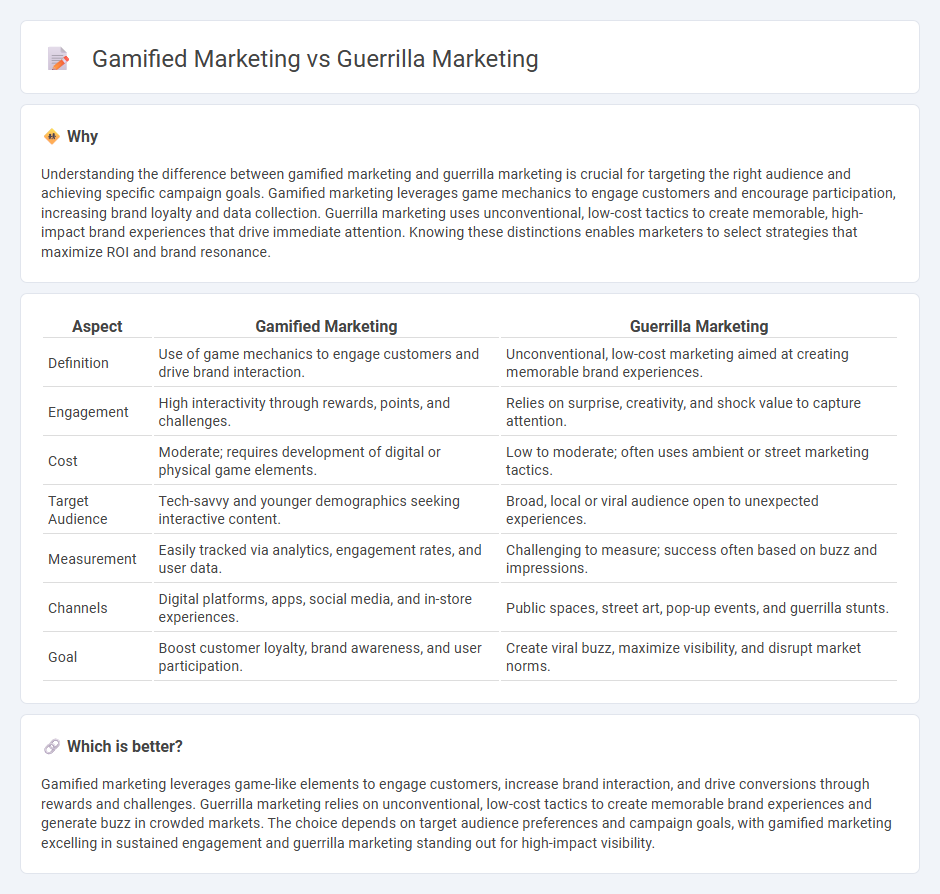
Gamified marketing leverages game design elements to enhance consumer engagement and brand interaction, creating immersive experiences that drive loyalty and conversion rates. Guerrilla marketing employs unconventional, high-impact tactics in public spaces to generate buzz and maximize exposure with minimal budget. Discover how these innovative strategies can transform your marketing approach and boost your brand's visibility.
Why it is important
Understanding the difference between gamified marketing and guerrilla marketing is crucial for targeting the right audience and achieving specific campaign goals. Gamified marketing leverages game mechanics to engage customers and encourage participation, increasing brand loyalty and data collection. Guerrilla marketing uses unconventional, low-cost tactics to create memorable, high-impact brand experiences that drive immediate attention. Knowing these distinctions enables marketers to select strategies that maximize ROI and brand resonance.
Comparison Table
| Aspect | Gamified Marketing | Guerrilla Marketing |
|---|---|---|
| Definition | Use of game mechanics to engage customers and drive brand interaction. | Unconventional, low-cost marketing aimed at creating memorable brand experiences. |
| Engagement | High interactivity through rewards, points, and challenges. | Relies on surprise, creativity, and shock value to capture attention. |
| Cost | Moderate; requires development of digital or physical game elements. | Low to moderate; often uses ambient or street marketing tactics. |
| Target Audience | Tech-savvy and younger demographics seeking interactive content. | Broad, local or viral audience open to unexpected experiences. |
| Measurement | Easily tracked via analytics, engagement rates, and user data. | Challenging to measure; success often based on buzz and impressions. |
| Channels | Digital platforms, apps, social media, and in-store experiences. | Public spaces, street art, pop-up events, and guerrilla stunts. |
| Goal | Boost customer loyalty, brand awareness, and user participation. | Create viral buzz, maximize visibility, and disrupt market norms. |
Which is better?
Gamified marketing leverages game-like elements to engage customers, increase brand interaction, and drive conversions through rewards and challenges. Guerrilla marketing relies on unconventional, low-cost tactics to create memorable brand experiences and generate buzz in crowded markets. The choice depends on target audience preferences and campaign goals, with gamified marketing excelling in sustained engagement and guerrilla marketing standing out for high-impact visibility.
Connection
Gamified marketing and guerrilla marketing both leverage interactive and unconventional tactics to engage audiences deeply and create memorable brand experiences. By incorporating game elements into unexpected, low-cost guerrilla campaigns, marketers enhance customer participation and emotional resonance, driving higher brand recall and social sharing. These strategies synergize to disrupt traditional advertising norms and foster authentic consumer connections through immersive, playful interactions.
Key Terms
**Guerrilla Marketing:**
Guerrilla marketing leverages unconventional, low-cost tactics to create high-impact brand awareness through surprise and creativity, often in public spaces, engaging audiences in memorable ways. This strategy emphasizes real-world interactions and viral potential, maximizing exposure without extensive advertising budgets, making it ideal for startups and small businesses. Explore how guerrilla marketing can transform your outreach efforts and boost brand visibility in unique ways.
Unconventional Tactics
Guerrilla marketing uses surprise and creativity to engage audiences through unconventional tactics like street art, flash mobs, or viral stunts that maximize impact with minimal budgets. Gamified marketing integrates game mechanics such as points, rewards, and challenges into campaigns to boost customer interaction and loyalty. Explore the distinct advantages of each approach to enhance your marketing strategy effectively.
Low Budget
Guerrilla marketing utilizes unconventional, low-cost tactics like street art, flash mobs, and viral content to create a high-impact, memorable brand presence. Gamified marketing engages audiences by incorporating game mechanics, such as points, badges, and leaderboards, into campaigns to boost interaction and loyalty with minimal financial investment. Discover how these budget-friendly strategies can transform your marketing efforts by exploring case studies and expert insights.
Source and External Links
Guerrilla marketing - Wikipedia - Guerrilla marketing is an advertising strategy using surprise and unconventional interactions to promote a product or service, aiming to create memorable experiences that generate buzz and word-of-mouth promotion, often at low cost and with a focus on creativity and emotional impact.
What Is Guerrilla Marketing? 4 Types and Examples to Delight ... - Guerrilla marketing uses unconventional, inventive public displays and human interactions in urban spaces to surprise and engage customers, driving publicity and brand awareness often through social media and word-of-mouth on a small budget.
Guerrilla Marketing: understand what it is and how to do it - Salesforce - This marketing strategy captures attention creatively and unexpectedly, increasing customer engagement, expanding brand reach through viral social media shares, and offering low-cost, high-impact alternatives to traditional advertising.
 dowidth.com
dowidth.com